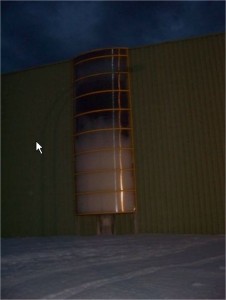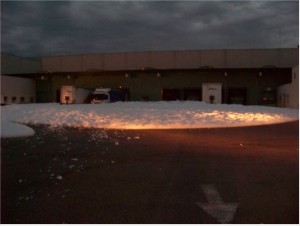At 6:56 pm inside a warehouse for phytosanitary products assigned an upper-tier Seveso classification, the activation of a foam-based automatic extinction system installed in a 1,000-m² cell brought fire-fighters to the scene 44 min later. By the time responders arrived, the foam had filled the cell and hit the 10-m high ceiling.
A team of 3 fire-fighters wearing self-breathing apparatuses entered an adjoining room to verify that the fire doors were indeed closed. As they progressed, all physical and radio contact was lost with one of them, a 46-year-old, experienced female officer (lieutenant rank). The victim was found in a comatose state without her breathing device and detached from her lifeline. During her evacuation, another responder slightly injured his hand. The mayor, local police, Prefect and inspection authorities all visited the site.
The pump on the foam injection system malfunctioned due to overuse, given that both the water and emulsifier reserves had been depleted. When opening the doors to a utility room, the foam engulfed the site’s exterior zones over a height ranging from 50 to 150 cm. Liquid effluent remained confined in the cell and on the parking lot.
The comatose victim died 3 days later; her emergency response equipment (suit, mask, cord) was seized by the court for investigation and the foam was analysed. The persistence of this foam inside the building for several days interfered with the forensics investigations ordered by the court. An inspection of the targeted cell, made accessible a few days later, did not reveal any evidence of a fire outbreak, and the hypothesis of an untimely triggering of the fire detection system subsequent to a short-circuit was deemed the most plausible. Damage and production losses amounted to a combined €750,000.
An autopsy of the victim confirmed death by asphyxiation. The judicial expert’s report indicated that the foam was of an abnormally compact and sticky texture (like cottage cheese), requiring the trio of responders to consume far more air with their breathing apparatus, along with a breach in the seal of their masks, which slid down their faces. Given the foam’s density, the victim had no visual contact and was unable to communicate with her two colleagues. She had lost contact with her immediate partner due to the fact that the personal connecting cord had been attached to the karabiner on the partner’s backpack, while it should have been via the belt. When her fellow responders decided to turn back, owing to a lack of air in their self-breathing devices, they removed their backpacks leaving the victim alone, disoriented, short of air and unaware of their decision. Only a single event with bodily injury subsequent to activation of an automatic extinction system had, until that time, been recorded in the ARIA base (ARIA 26999).
Download the detailed report in .pdf format (1.3 Mb)





